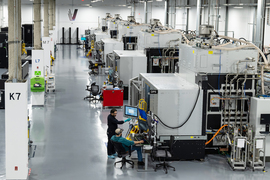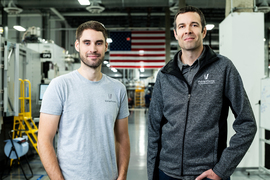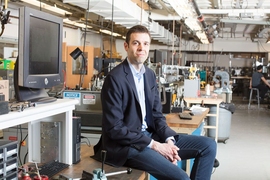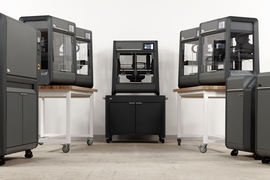The cutting edge of additive manufacturing offers a world of possibilities for companies looking to transform their manufacturing processes and create new products. But companies that want to tap into that world have traditionally had to invest huge sums of money into the latest 3D printing machines and then figure out how to integrate them into their operations.
That’s a tough sell considering 3D printers can struggle with throughput and consistency for many industrial applications.
Now, VulcanForms, founded by Martin C. Feldmann MEng ’14 and MIT Professor John Hart, is offering digital manufacturing as a service for companies to build industrial products at scale. The company assists customers with materials selection and product design, and then crafts a scalable manufacturing workflow in its production foundry.
At the heart of each of those workflows is a proprietary laser powder bed fusion (LPBF) metal 3D printer that uses an array of finely choreographed laser beams to produce high performance metal parts with complex designs. The printers are integrated with VulcanForms’ machining, robotics, and postprocessing equipment through a digital thread that also monitors parts as they’re produced.
“Even though LPBF technology is well-established for several applications including jet engine fuel nozzles and orthopedic implants, it’s barely scratching the surface of the opportunity,” Hart says. “VulcanForms sees a tremendous market opportunity to realize additive manufacturing at industrial scale and integrate it with a digital production system.”
VulcanForms is currently producing parts for companies in the medical, defense, semiconductor, and aerospace industries, turning designs into finished parts in a matter of days. The founders say VulcanForms’ quality exceeds industry standards with materials like titanium as well as nickel-based and advanced steel alloys.
VulcanForms is currently completing its first two digital manufacturing facilities in Devens and Newburyport, Massachusetts. When it’s done, the Devens facility will house several dozen of the company’s additive manufacturing systems in addition to having postprocessing capabilities. The founders say those systems will make Devens the highest-throughput metal additive manufacturing facility in the world. The Newburyport facility focuses on precision machining, industrial automation, and assembly operations. Merging these technologies with a digital thread, VulcanForms is building U.S.-based digital manufacturing infrastructure that the founders say will define the way products are designed, built, and delivered.
Making 3D printing industrially relevant
Hart calls his entry into additive manufacturing serendipitous. In 2013, he was asked by a colleague to teach a class for MIT’s Masters of Engineering in Advanced Manufacturing and Design program.
“I don’t remember what led me to propose that the class focus on additive manufacturing, because I wasn’t yet doing research in the area,” Hart says. “The class was an experiment I used to explore a new interest and to tap into the passion and curiosity of the students.”
One of the students in that class was Feldmann, then in his first semester at MIT. The project-based class tasked students with measuring the accuracy of 3D-printed parts, improving their properties and contributing to lectures relating 3D printing to the core principles of manufacturing.
“MIT throws so much at you — highly technical stuff but very applicable stuff,” Feldmann says. “At MIT, learning additive manufacturing wasn’t just calculating things. It was, ‘Here are [fused deposition modeling] printers, tell me what their capabilities are.’ And you use them and make things. I really enjoyed that. It prepares one for leading research efforts in industry and startups because you have to approach things like you know what you’re doing and have the confidence that you'll figure it out.”
After earning his degree, Feldmann became a research specialist in Hart’s lab, where he studied nanomaterials and battery electrodes. But Feldmann and Hart continued brainstorming ways to make additive manufacturing more industrially relevant.
Eventually they decided to build a new kind of LPBF metal printer that would enable a large number of lasers to operate at the same time, improving throughput while maintaining the quality of the finished part. The pair received early guidance through MIT’s Venture Mentoring Service.
“Our goal was to rearchitect the LPBF process, and to do it in a way that enables a much higher and more consistent quality, which we saw to be the main impediment to industrialization of additive manufacturing.” Hart says.
With that mission in mind, Feldmann and Hart decided to take the leap and start VulcanForms, with Feldmann essentially supporting himself for nearly two years while he worked on the first printer prototype. Today the company’s printers use hundreds of weld tracks in each layer through which lasers move in a synchronized dance. The lasers collectively deliver up to 100 kilowatts of power to make parts at a higher resolution and scale than the founders say other printers can achieve.
VulcanForms’ production foundry also includes CNC machining and post processing equipment, and the founders say the company’s software stack is a key differentiator.
“From the start, we saw 3D printing as a cornerstone of digital manufacturing, where the software and hardware work hand-in-hand to encode and execute production instructions,” Hart says. “We’ve built the software that allows each part to receive the same temperature locally in each voxel in each layer. It also allows us to move quickly to the end product while maintaining that consistency in production.”
Ultimately the founders are focused on what those capabilities unlock for customers.
“What really gets me excited is how we’re able to take a customer part and turn it into reality in a production setting — not in a coat hanger or desk ornament setting,” Feldmann says. “Everyone in additive is just super excited about what a 3D printer can do and not how this works in a production value stream. That’s why we have an entire production value stream in house. It’s why our motto isn’t ‘VulcanForms: 100 kilowatts laser power in a printer.’ It’s ‘VulcanForms: accelerating innovation.’”
Helping 3D printing reach its potential
Last year, a supercomputer manufacturer sent VulcanForms designs for a cooling component in its processors. The titanium part, which contained dozens of microscopic tunnels, was so complex it could only be made using additive manufacturing. As The New York Times reported, VulcanForms came back with a part two days later.
VulcanForms has also produced medical implants, industrial tooling and tire molds, and components for aviation and defense contractors.
Feldmann sees innovations enabled by additive manufacturing driving technological progress in a number of industries.
“I don’t think there are going to be orthopedic implants that aren’t LPBF-printed in the future,” Feldmann says.
That technological progress, in turn, will yield even more use cases.
“The only thing I’m 100 percent sure of is the highest-value applications for additive manufacturing have not yet been found,” Feldmann says.
The company also sees the transformation of manufacturing enabled by digital production technologies as an opportunity for the United States to improve both economic prosperity and its ecosystem of innovation.
“VulcanForms believes that one of the greatest opportunities in the United States is rebuilding its industrial ecosystem around digital production systems,” Hart says. “Digital-first production technologies, including additive manufacturing and automated precision machining, enable more innovative, resource efficient, and resilient supply chains. Innovation in manufacturing is the backbone of the American economy.”












